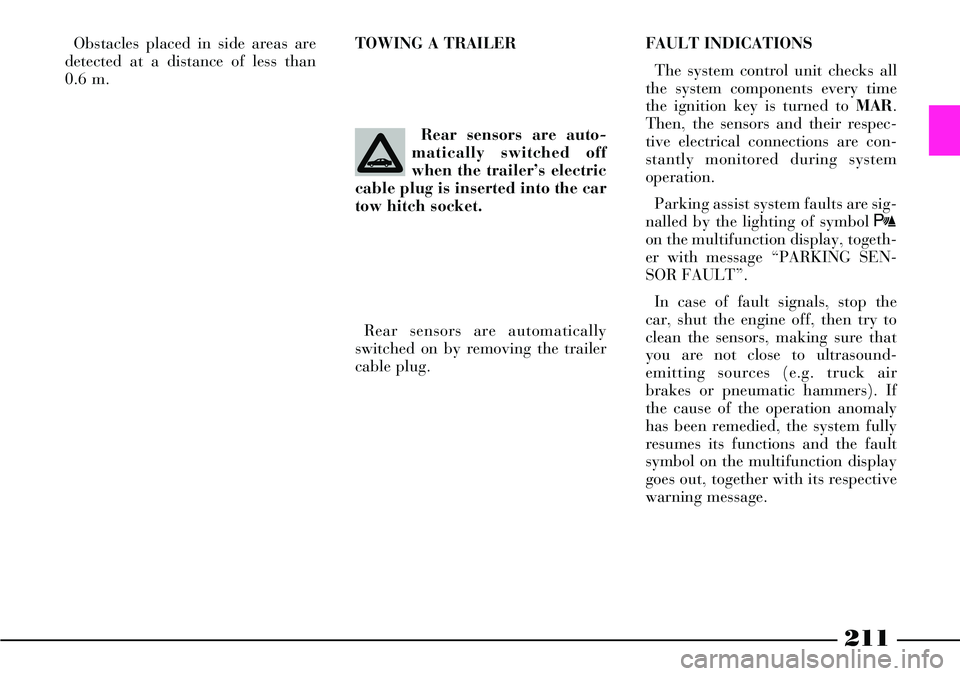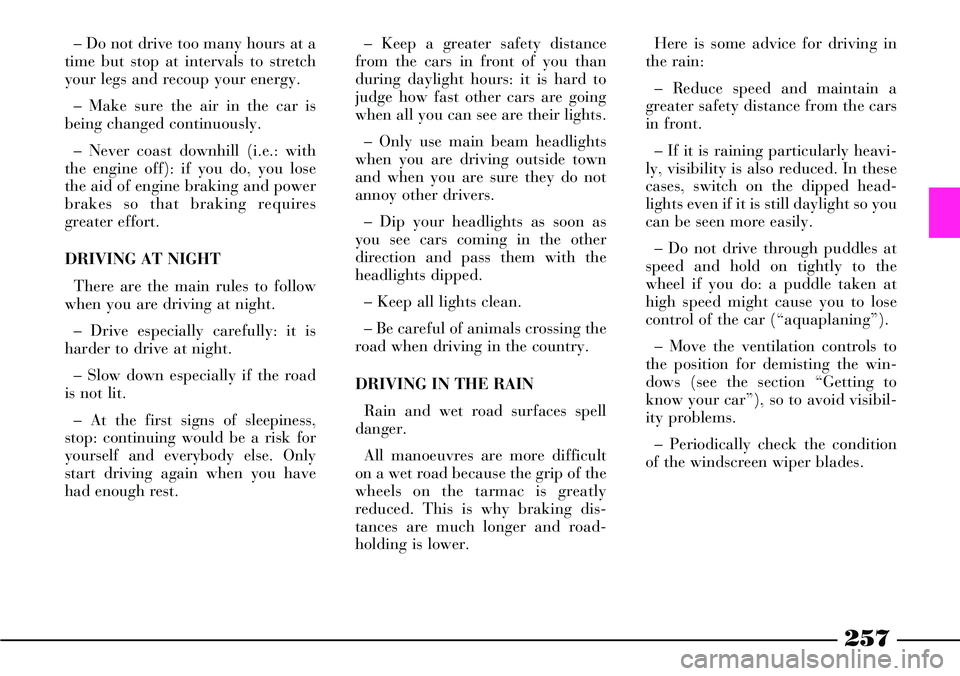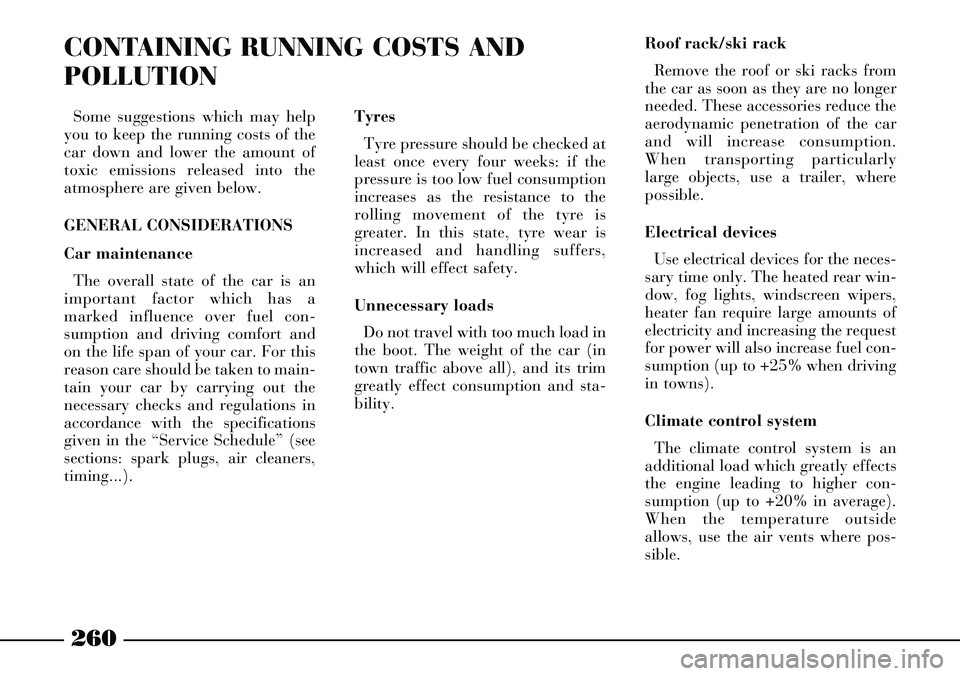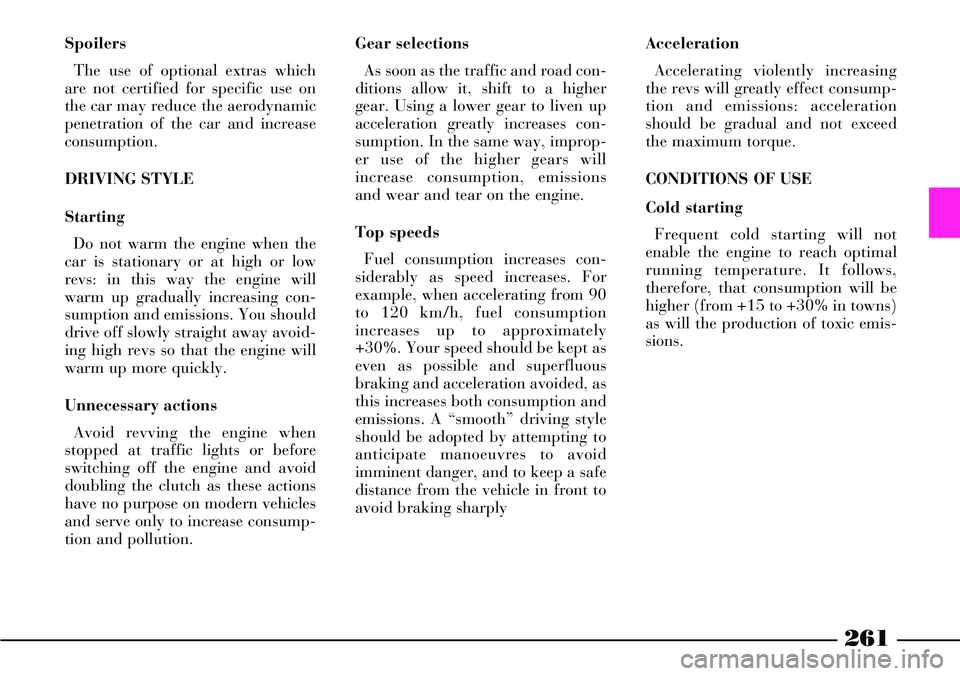tow Lancia Thesis 2006 Owner handbook (in English)
[x] Cancel search | Manufacturer: LANCIA, Model Year: 2006, Model line: Thesis, Model: Lancia Thesis 2006Pages: 386, PDF Size: 8.69 MB
Page 184 of 386

183
R - Reverse
Shift the lever to Rwith the car
stationary, the engine running idle
and the brake pedal pressed.
When the lever is at Rbackup
lights turn on and a buzzer will
sound for about 4 seconds to warn
other people that reversing is in
progress.
IMPORTANTEven with the lever
in position R, the reverse gear can-
not be engaged if the car speed is
higher than the established value.
When the speed is reduced, the
reverse gear can be engaged and it
remains engaged even if the car
speed overcomes that limit.N - Neutral
This is the position to be used when
the car must be pushed or towed.
D - Forward gear (automatic)
This is the position to be used when
all automatic gearbox functions are
required.
The electronic control unit controls
that the five gears are engaged auto-
matically according to car speed,
engine rpm, accelerator pedal posi-
tion and pressing speed, together
with the main driving conditions
such as hills, slopes, curves and
braking.
Indeed, the electronic automatic
gearbox is able to choose, according
to the type of driving adopted by the
driver, different programmes subdi-
vided into comfortable driving,
economy driving and sporty driving,
with shift points ranging between
low and high. Before leaving the car,
check that the electric
parking brake (EPB) is
on. Shift the lever to position P
even when the car is left with the
engine running.
In case of emergency (failures, flat
battery, etc.), it is possible to shift
the lever from position Pto N, D or
Rby pressing lever A(fig. 141) set
under the gear lever mask. To reach
the lever, remove the press-fit odd-
ment compartment shelf Bin front
of the gearshift lever.
fig. 141
L0A0276b
Page 189 of 386

188
If the failure is signalled when the
engine is started, it means that the
electronic control unit had stored it
previously, before stopping the
engine. Even in this case, go to a
Lancia Dealershipto have the
automatic gearbox checked.
When driving with auto-
matic gearbox faulty,
drive carefully consider-
ing the limited car efficiency in
terms of acceleration and speed.
In addition, when driving with
automatic gearbox faulty, the
reverse block might not be oper-
ating: for this reason it is
absolutely necessary to move the
lever to position R while the car
is moving.SOUND SIGNAL
A buzzer will sound in the follow-
ing conditions:
– for about 15 seconds when the
driver’s door is opened while the
engine is running or not and the gear
lever has a position different from P
– for about 15 seconds when the
engine is turned off and the gear
lever has a position different from P
– for about 4 seconds when the
gear lever is shifted to R(reverse)
– with the manual sequential oper-
ation on, when the selected gear is
not accepted by the electronic con-
trol unit (e.g. since it might generate
a runaway speed rate). BUMP STARTING
Never bump starting the engine (by
pushing, towing, etc.). In an emer-
gency, when the battery is flat, start
the engine with the appropriate
emergency battery according to the
instructions contained in chapter “In
an emergency”.
Page 190 of 386

189
If these rules are not
respected, the automatic
gearbox might be severely
damaged.
The car can be towed only for
short distances and at a low
speed: if it is necessary to tow it
for a longer distance, raise the
driving wheels so that the gear-
box is not dragged during towing. TOWING THE CAR
IMPORTANTTo tow the car
observe local current laws and fol-
low the instructions contained in
chapter “In an emergency”.
If the car must be towed, observe
the following precautions:
– if possible, transfer the car on a
towtruck
– otherwise, tow the car by raising
the front driving wheels
– even if the latter solution is not
possible, the car can be towed for
less than 50 Km at a speed of 50
km/h.
Towing shall be performed with
gear lever to N.Before starting towing,
disengage the parking
brake as described in the
relevant paragraph and leave the
Keyless System CID (if any) in the
passenger’s compartment to pre-
vent automatic steering lock. Do
not tow the car with the engine
running.
ESP AND ASR
SYSTEMS
ESP SYSTEM (ELECTRONIC
STABILITY PROGRAM):
GENERAL
ESP is an electronic system con-
trolling the car stability which
affects the driving torque and brakes
the wheels in a different way in case
of grip loss, thus making the car
recover the right driving direction.
During driving the car is subject to
side and longitudinal forces which
can be controlled by the driver until
tire grip is acceptable. When the lat-
ter is lower than the minimum level,
the car starts skidding.
If the road bed is uneven (bumpy
road, presence of ice, mould, etc.)
tyre grip is considerably reduced. In
these conditions, when extreme
manoeuvres are made, the car might
start skidding.
Page 212 of 386

211
Obstacles placed in side areas are
detected at a distance of less than
0.6 m.
Rear sensors are automatically
switched on by removing the trailer
cable plug.FAULT INDICATIONS
The system control unit checks all
the system components every time
the ignition key is turned to MAR.
Then, the sensors and their respec-
tive electrical connections are con-
stantly monitored during system
operation.
Parking assist system faults are sig-
nalled by the lighting of symbol t
on the multifunction display, togeth-
er with message “PARKING SEN-
SOR FAULT”.
In case of fault signals, stop the
car, shut the engine off, then try to
clean the sensors, making sure that
you are not close to ultrasound-
emitting sources (e.g. truck air
brakes or pneumatic hammers). If
the cause of the operation anomaly
has been remedied, the system fully
resumes its functions and the fault
symbol on the multifunction display
goes out, together with its respective
warning message. Rear sensors are auto-
matically switched off
when the trailer’s electric
cable plug is inserted into the car
tow hitch socket.TOWING A TRAILER
Page 254 of 386

253
Remember that until the
engine has started, the
brake booster and power
steering systems will not work
and a greater effort will therefore
be required to press the brake
pedal and turn the steering
wheel. For cars equipped with
turbosupercharger in
particular, but generally
for any kind of cars, avoid abrupt
accelerations immediately before
turning the engine off. A quick
burst on the accelerator serves
absolutely no practical purpose,
wastes fuel and may damage seri-
ously the turbosupercharger
rotor bearings.EMERGENCY START-UP
If the Lancia CODE system fails to
recognise that code transmitted by
the ignition key (symbol Ytogeth-
er with message “VEHICLE PRO-
TECTION SYSTEM FAULT” on the
multifunction display) the emer-
gency start-up can be performed by
using the CODE card code.
For the correct procedure see chap-
ter “In an emergency”.
Before opening the lug-
gage compartment bonnet
to reload the battery or to
connect an auxiliary battery,
carefully read and comply with
the instructions contained in the
paragraph “If battery is to be dis-
connected” in the chapter “In an
emergency”. Never bump start the
engine (by pushing, tow-
ing or coasting downhill)
as this could cause fuel to flow
into the catalytic exhaust system
and damage it beyond repair.
IMPORTANTIf the engine turns
off while the car is running, the
Lancia CODE symbol Yand the
message “VEHICLE PROTECTION
SYSTEM FAULT” may appear on
the multifunction display when the
engine starts again. In this case
check that the warning light switch-
es off when turning the engine off
and on again with the car stationary.
Otherwise contact aLancia
Dealership.
Page 258 of 386

257
– Keep a greater safety distance
from the cars in front of you than
during daylight hours: it is hard to
judge how fast other cars are going
when all you can see are their lights.
– Only use main beam headlights
when you are driving outside town
and when you are sure they do not
annoy other drivers.
– Dip your headlights as soon as
you see cars coming in the other
direction and pass them with the
headlights dipped.
– Keep all lights clean.
– Be careful of animals crossing the
road when driving in the country.
DRIVING IN THE RAIN
Rain and wet road surfaces spell
danger.
All manoeuvres are more difficult
on a wet road because the grip of the
wheels on the tarmac is greatly
reduced. This is why braking dis-
tances are much longer and road-
holding is lower.Here is some advice for driving in
the rain:
– Reduce speed and maintain a
greater safety distance from the cars
in front.
– If it is raining particularly heavi-
ly, visibility is also reduced. In these
cases, switch on the dipped head-
lights even if it is still daylight so you
can be seen more easily.
– Do not drive through puddles at
speed and hold on tightly to the
wheel if you do: a puddle taken at
high speed might cause you to lose
control of the car (“aquaplaning”).
– Move the ventilation controls to
the position for demisting the win-
dows (see the section “Getting to
know your car”), so to avoid visibil-
ity problems.
– Periodically check the condition
of the windscreen wiper blades. – Do not drive too many hours at a
time but stop at intervals to stretch
your legs and recoup your energy.
– Make sure the air in the car is
being changed continuously.
– Never coast downhill (i.e.: with
the engine off): if you do, you lose
the aid of engine braking and power
brakes so that braking requires
greater effort.
DRIVING AT NIGHT
There are the main rules to follow
when you are driving at night.
– Drive especially carefully: it is
harder to drive at night.
– Slow down especially if the road
is not lit.
– At the first signs of sleepiness,
stop: continuing would be a risk for
yourself and everybody else. Only
start driving again when you have
had enough rest.
Page 261 of 386

260
CONTAINING RUNNING COSTS AND
POLLUTION
Some suggestions which may help
you to keep the running costs of the
car down and lower the amount of
toxic emissions released into the
atmosphere are given below.
GENERAL CONSIDERATIONS
Car maintenance
The overall state of the car is an
important factor which has a
marked influence over fuel con-
sumption and driving comfort and
on the life span of your car. For this
reason care should be taken to main-
tain your car by carrying out the
necessary checks and regulations in
accordance with the specifications
given in the “Service Schedule” (see
sections: spark plugs, air cleaners,
timing...).Tyres
Tyre pressure should be checked at
least once every four weeks: if the
pressure is too low fuel consumption
increases as the resistance to the
rolling movement of the tyre is
greater. In this state, tyre wear is
increased and handling suffers,
which will effect safety.
Unnecessary loads
Do not travel with too much load in
the boot. The weight of the car (in
town traffic above all), and its trim
greatly effect consumption and sta-
bility.Roof rack/ski rack
Remove the roof or ski racks from
the car as soon as they are no longer
needed. These accessories reduce the
aerodynamic penetration of the car
and will increase consumption.
When transporting particularly
large objects, use a trailer, where
possible.
Electrical devices
Use electrical devices for the neces-
sary time only. The heated rear win-
dow, fog lights, windscreen wipers,
heater fan require large amounts of
electricity and increasing the request
for power will also increase fuel con-
sumption (up to +25% when driving
in towns).
Climate control system
The climate control system is an
additional load which greatly effects
the engine leading to higher con-
sumption (up to +20% in average).
When the temperature outside
allows, use the air vents where pos-
sible.
Page 262 of 386

261
Gear selections
As soon as the traffic and road con-
ditions allow it, shift to a higher
gear. Using a lower gear to liven up
acceleration greatly increases con-
sumption. In the same way, improp-
er use of the higher gears will
increase consumption, emissions
and wear and tear on the engine.
Top speeds
Fuel consumption increases con-
siderably as speed increases. For
example, when accelerating from 90
to 120 km/h, fuel consumption
increases up to approximately
+30%. Your speed should be kept as
even as possible and superfluous
braking and acceleration avoided, as
this increases both consumption and
emissions. A “smooth” driving style
should be adopted by attempting to
anticipate manoeuvres to avoid
imminent danger, and to keep a safe
distance from the vehicle in front to
avoid braking sharplyAcceleration
Accelerating violently increasing
the revs will greatly effect consump-
tion and emissions: acceleration
should be gradual and not exceed
the maximum torque.
CONDITIONS OF USE
Cold starting
Frequent cold starting will not
enable the engine to reach optimal
running temperature. It follows,
therefore, that consumption will be
higher (from +15 to +30% in towns)
as will the production of toxic emis-
sions. Spoilers
The use of optional extras which
are not certified for specific use on
the car may reduce the aerodynamic
penetration of the car and increase
consumption.
DRIVING STYLE
Starting
Do not warm the engine when the
car is stationary or at high or low
revs: in this way the engine will
warm up gradually increasing con-
sumption and emissions. You should
drive off slowly straight away avoid-
ing high revs so that the engine will
warm up more quickly.
Unnecessary actions
Avoid revving the engine when
stopped at traffic lights or before
switching off the engine and avoid
doubling the clutch as these actions
have no purpose on modern vehicles
and serve only to increase consump-
tion and pollution.
Page 263 of 386

262
Traffic and road conditions
Heavy traffic and higher consump-
tion are synonymous, for example
when driving slowly with frequent
use of lower gears or in towns where
there are numerous traffic lights.
Winding roads, mountain roads
and bumpy roads also have a nega-
tive effect on consumption.
Enforced halts
During prolonged stops (level
crossings, etc.) the engine should be
switched off.Environmental protection has been
one of the guiding principles in the
production of the THESIS.
It is not accident that its pollution
control equipment is much more
effective than that required by cur-
rent legislation.
Nonetheless, the environment can-
not get by without a concerted effort
from everyone.
By following a few simple rules you
can avoid harming the environment
and often cut down fuel consump-
tion at the same time. On this sub-
ject, a few useful tips have been
given below to supplement those
marked by symbol #, at various
points of the handbook.
You are asked to read both the for-
mer and the latter carefully.CHEAP RUNNING THAT RESPECTS THE
ENVIRONMENT
LOOKING AFTER EMISSION
CONTROL DEVICES
The correct use of pollution control
devices not only ensures respect for
the environment but also has an
effect on the car’s performance.
Keeping these devices in good condi-
tion is therefore a fundamental rule
for driving that is easy on your
pocket and on the environment too.
The first step is to follow the
“Service Schedule” to the letter.
Only use unleaded petrol for petrol
engines (95 RON), for JTD versions
only diesel fuel (EN590 specifica-
tion).
Page 264 of 386

263
Ignoring the above rules
may lead to fire. When functioning nor-
mally, the catalytic con-
verter reaches high tem-
peratures. For this reason, do not
park the car over inflammable
material (grass, dry leaves, pine
needles, etc.): fire hazard.
Do not allow anything to
be sprayed onto the cat-
alytic converter, lambda
sensor and exhaust pipe. Do not install other heat
shields and do not remove
those already fitted to the
catalytic converter and exhaust
pipe. Never run the engine with the
spark plugs disconnected even for
testing purposes. Do not warm up
the engine by letting it idle for a
while before moving off unless the
outside temperature is very low and,
even in this case, only do so for less
than 30 seconds.
If you have trouble starting, do not
keep turning the ignition key for
long periods. Be especially careful to
avoid bump starting the car by
pushing, towing or rolling downhill:
these are all manoeuvres that can
damage the catalytic exhaust sys-
tem. Use an auxiliary battery for
start-ups only.
If the engine begins to “lose its
smoothness” when travelling, con-
tinue your journey but reduce the
demands you are making on the
engine and have the car seen at a
Lancia Dealershipas soon as you
can.
When the instrument panel fuel
reserve warning light comes on, fill
up as soon as possible. A low level of
fuel can cause an uneven supply of
fuel to the engine with the inevitable
increase in the temperature of the
exhaust gas and serious damages to
the catalytic converter.